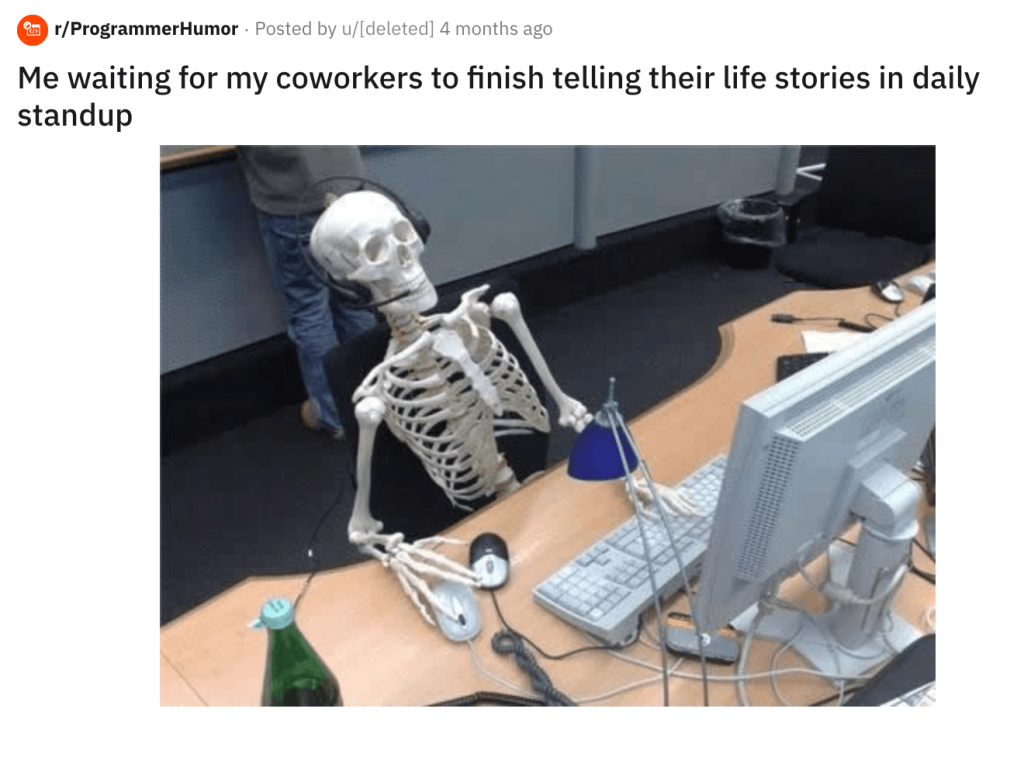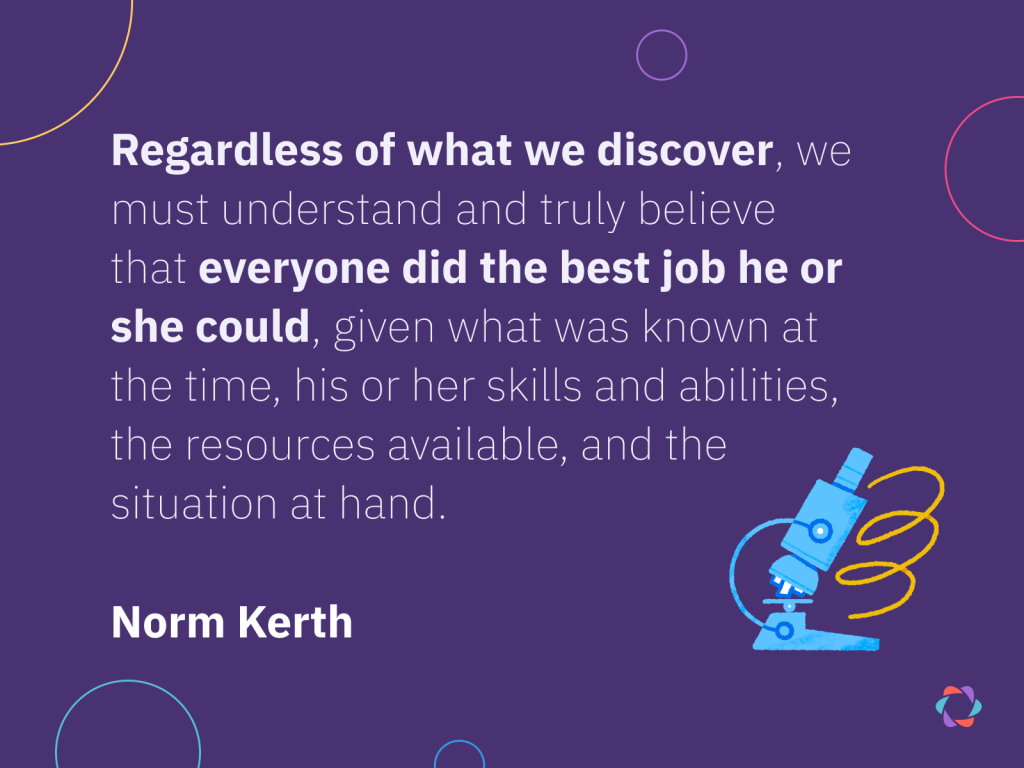What to Say in Standup Meetings: 10 Rules for Better Updates

An essential daily standup skill to master is knowing what to say and what not to say. For many agile teams, the daily standup meeting is used to inspect progress, identify issues, and make minor changes to your plans.
But too often it turns into an occasion for intricate problem-solving, long-winded discussions, status reports, or on-the-spot action.
To know what to say in standup meetings, keep these 10 simple principles in mind:
- Only mention what’s relevant for most meeting participants
- Focus on items that impact today’s work
- Communicate blockers that affect your work
- Acknowledge dependencies you’re responsible for
- Hold each other accountable
- Highlight remarkable problems when you’ve found them
- Make changes to the existing plan
- Ask for specific help when you need it
- Offer help when you can give it
- Mention completed tasks others need to know about
👩🏾🎓 Check out our Daily standups hub for all our resources on running better standup meetings.
1. Only mention what’s relevant for most meeting participants
If you want to remember just one item from this list, let this be your golden rule for daily standups: Only discuss what’s relevant for most attendees.

Most issues with the daily standup – the meeting running over time, people’s minds checking out early – stem from conversations that are only relevant for a few folks.
“I have made this [letter] longer than usual because I have not had time to make it shorter.”
Blaise Pascal (1623–1662), French mathematician and philosopher
Had Blaise Pascal lived today, he might have been a developer writing something similar about daily standups. Keeping them short is an art that takes preparation and practice.
For a great standup update, don’t:
- Enter into details and back-and-forth conversations about tasks, problems, and projects.
- Give statements that hold no value for anyone, like “I did the same as yesterday,” or “I’m going to write some code today.”
- Talk to just one person about a topic.
- Make the standup about you. Save your personal problems and opinions for your one-on-one meeting.
Keep your answers short. Consider carefully what information everyone should hear and what’s better discussed with a few people afterward.
“We had a huge all-hands meeting at Apple once … And a guy stands up during the Q&A and starts asking Steve Jobs why he didn’t get a raise or a good review. Steve looks at him in stunned disbelief and says, ‘I can tell you why. Because you’re asking this question in front of ten thousand people.’”
Tony Fadell in “Build”
When someone does transgress, all meeting participants should feel comfortable calling a stop to the discussion and proposing to park the topic until after the standup.
2. Focus on items that impact today’s work
In the Scrum methodology, teams run a version of standups called the Daily Scrum. The Daily Scrum should focus “on progress toward the Sprint Goal” and produce “an actionable plan for the next day of work,” according to the Scrum Guide.
These guidelines mean the meeting should focus on topics related to today’s work, roughly tackling:
- Adaptation: Is there anything we need to change about our plans to achieve the Sprint Goal?
- Short-term planning: What do we need to complete and discuss today to stay on track to meet the Sprint Goal?
- Impediments: What stands in the way of today’s work?
You don’t literally have to ask these questions, but these prompts reflect what the daily standup should achieve for most teams.
Don’t ignore upcoming due dates because of this rule to focus on the present. A deadline looming next week is a perfectly viable topic to bring up since it might affect what the team should work on today.
Check out 57 Daily Standup Questions for More Engaging Updates if you’re looking for prompts to use in your daily standups.
3. Communicate blockers that affect your work
When something or someone blocks your work, the daily standup is an excellent opportunity to raise the issue. You can get advice, help, or clarify why something is stuck.

Doing so isn’t always easy, especially if someone is the blocker. Here are tips on how to bring up people impediments during the daily standup:
- Remember the Prime Directive. Assume that everyone is doing the best job they can given their circumstances.
- Stick to facts and observations. State what you need, from whom, and by when you need(ed) it. Don’t add presumptions about why the other person should find the task easy, difficult, or how much time it should take.
- Highlight what’s at stake if getting what you need seems challenging. That way, everyone understands the trade-off between resolving your impediment now versus leaving it for later.
Whichever blocker you report, keep in mind the golden rule: there has to be a reason the entire group must know about it. For example, if you have a broken laptop, you need to talk to IT or your boss, not the standup crowd.
4. Acknowledge dependencies you’re responsible for
When you know someone is waiting for something from you, be proactive about mentioning it. Acknowledge during the daily standup that the item is still pending on your to-do list and give a realistic estimate of when you expect to get it done.
Following this rule has several benefits:
- You save the other person from worrying about bringing it up as a blocker. While the entire team should feel comfortable sharing blockers caused by others, that still doesn’t make it easy or pleasant for most folks.
- The other person knows it’s on your radar and can adjust their plans by rearranging their work or finding another solution.
- You can get help more quickly. Other meeting participants with less on their plates get an opportunity to offer help or take on the item from you.
5. Hold each other accountable
Team members should hold each other accountable for getting their work done. So don’t feel bad asking if someone needs help when a task hasn’t been completed.
Achieving accountability as a team is challenging. You need trust and lots of it, so that:
- People dare to tell each other when they’re not meeting their commitments without worrying about igniting arguments or retaliation.
- Political games aren’t dictating people’s remarks.
- Feedback is about the work and never about the person.
Say someone committed to complete a task by Wednesday. By Thursday, you notice it’s still not done, and they don’t mention anything about it during the standup. In that case, other team members should feel comfortable to inquire what’s going on, regardless of each person’s title or seniority.
“No group ever becomes a team until it can hold itself accountable as a team … Think, for example, about the subtle but critical difference between ‘the boss holds me accountable’ and ‘we hold ourselves accountable.’ The first case can lead to the second; but without the second, there can be no team.”
“The Wisdom of Teams” by Douglas Smith and Jon Katzenbach
Don’t mistake this rule as a free pass to give someone critical feedback in front of their peers. Creating accountability about work items and commitments is necessary during a daily standup. Telling someone they’re underperforming and need to improve should be reserved for one-on-one meetings.
6. Highlight remarkable problems when you’ve found them
When you find a seemingly unfixable problem that might impact the customer or other teams, mention it during the standup.
Others can then offer help, take responsibility, or mitigate the issue for their stakeholders and plans. Don’t go into problem-solving mode, though. Schedule a Lean Coffee or similar meeting with a few folks after the daily standup to discuss solutions.
“Tell us bad news immediately — because good news takes care of itself. We can take bad news, but we don’t like it late.”
Warren Buffett
If you’re already planning to resolve the issue yourself, let others know when you’re working on it, any roadblocks you foresee, and when you expect to have it fixed. Don’t go into details about what you’re going to do exactly, how you found and analyzed the problem, and other such intricacies.
And if you’ve found a minor problem that you fixed already or will shortly? Then don’t mention it at all unless it impacts directly on the work of others.
7. Make changes to the existing plan
You can and should talk about any required changes to your plan to stay on track for the Sprint Goal. During a Sprint, Scrum allows you to make changes to the Sprint Backlog – which essentially reflects your plan for the Sprint – but not the Sprint Goal.
“The purpose of the Daily Scrum is to inspect progress toward the Sprint Goal and adapt the Sprint Backlog as necessary, adjusting the upcoming planned work.”
The Scrum Guide 2020 edition
The daily standup is an ideal moment to check how confident everyone feels about hitting the goal and make course corrections to stay on track.
For example, you could decide not to include a buggy auto-suggest feature to meet your objective of shipping a search function for your website.What you shouldn’t do during daily standups is to set or discuss new goals and plans. Dropping that search function to build a new chat feature is something you talk about and decide during Sprint Planning.
8. Ask for specific help when you need it
When you face a challenge and know what help you need but not who can give it, mention it during the daily standup. You’ll have the attention of a handful to a dozen people who might have a solution or someone else in the organization who does.
For example, you might mention that you’re looking for someone who can proofread a short text in French or give a second opinion on a piece of JavaScript code you wrote.
Don’t go into a long-winded issue you’re facing for which you don’t yet know what help you need. In such cases, you can still adhere to this principle, though.
Share during the standup that you’re facing a challenging problem and would like to discuss it with someone after the standup.
That’s a short and specific request for help that fits standups.
9. Offer help when you can give it
Thankfully, most of us are inclined to offer support to a teammate when they have an issue we can solve. We don’t have to dwell on that aspect of this principle for too long.
What does need attention is that many of us are too nice.
We offer help even when that jeopardizes our existing commitments and responsibilities. We then later also take the blame or overwork, the result of the fallout of the extra load we took on.
Make sure to highlight what you need to drop or de-prioritize when you offer help while your plate is already full so that someone else can step up and support you.
10. Mention completed tasks others need to know about
Daily standups shouldn’t be status updates. But you can share work items you’ve completed when that information might help you or others.
For example, you might share that you’ve fixed all the bugs you’re aware of related to a specific feature. You consider that work done unless someone has found any new problems.
In such a case, your status update serves a purpose: you’re confirming with others whether your work item is truly done so you can move on to the next one.
What do Product Owners and other stakeholders say during standups?
Nothing! The daily standup meeting is run by the development team for the development team. Product Owners (POs) and other stakeholders say nothing during Daily Scrum meetings 🤫 – unless they’re working on the team as developers or you’re using an alternative project management approach like daily huddles.
“The Daily Scrum is a 15-minute event for the Developers of the Scrum Team … If the Product Owner or Scrum Master are actively working on items in the Sprint Backlog, they participate as Developers.”
The Scrum Guide 2020 edition
The attendance of POs and stakeholders isn’t forbidden, but neither is it helpful. In their presence, a developer might feel uncomfortable following the principles we’ve just discussed and end up where we were at the start of this article: not knowing what to say in a standup meeting.
Make your life easy with Parabol’s online standup tool
Remote teams can do their standups manually on Zoom, Slack, or in front of a board. But Parabol’s online standup tool can make your life much easier. Why not try it out? It’s free!

We’ve run through every imaginable approach and tool for asynchronous standups ourselves but found that most:
- Disrupt your team’s flow of work.
- Involve sitting through long updates.
- Compromise those in different time zones.
- Get off track or run over time.
That’s why we’ve developed our own online standup solution. It saves your entire team time while staying up to date. You can share updates on your own time, set a cadence that suits your team, and review updates when you’re ready.
Looking for more daily standup resources?
Check out our daily standup hub or these other articles that cover different aspects of the art of standups:






